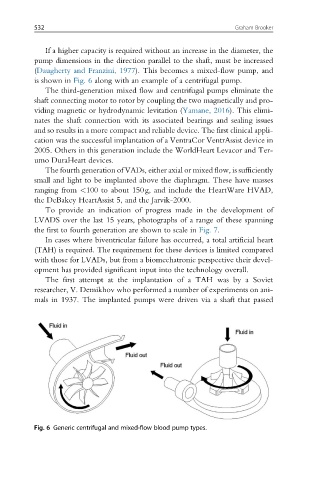Page 538 - Handbook of Biomechatronics
P. 538
532 Graham Brooker
If a higher capacity is required without an increase in the diameter, the
pump dimensions in the direction parallel to the shaft, must be increased
(Daugherty and Franzini, 1977). This becomes a mixed-flow pump, and
is shown in Fig. 6 along with an example of a centrifugal pump.
The third-generation mixed flow and centrifugal pumps eliminate the
shaft connecting motor to rotor by coupling the two magnetically and pro-
viding magnetic or hydrodynamic levitation (Yamane, 2016). This elimi-
nates the shaft connection with its associated bearings and sealing issues
and so results in a more compact and reliable device. The first clinical appli-
cation was the successful implantation of a VentraCor VentrAssist device in
2005. Others in this generation include the WorldHeart Levacor and Ter-
umo DuraHeart devices.
The fourth generation of VADs, either axial or mixed flow, is sufficiently
small and light to be implanted above the diaphragm. These have masses
ranging from <100 to about 150g, and include the HeartWare HVAD,
the DeBakey HeartAssist 5, and the Jarvik-2000.
To provide an indication of progress made in the development of
LVADS over the last 15 years, photographs of a range of these spanning
the first to fourth generation are shown to scale in Fig. 7.
In cases where biventricular failure has occurred, a total artificial heart
(TAH) is required. The requirement for these devices is limited compared
with those for LVADs, but from a biomechatronic perspective their devel-
opment has provided significant input into the technology overall.
The first attempt at the implantation of a TAH was by a Soviet
researcher, V. Demikhov who performed a number of experiments on ani-
mals in 1937. The implanted pumps were driven via a shaft that passed
Fig. 6 Generic centrifugal and mixed-flow blood pump types.

